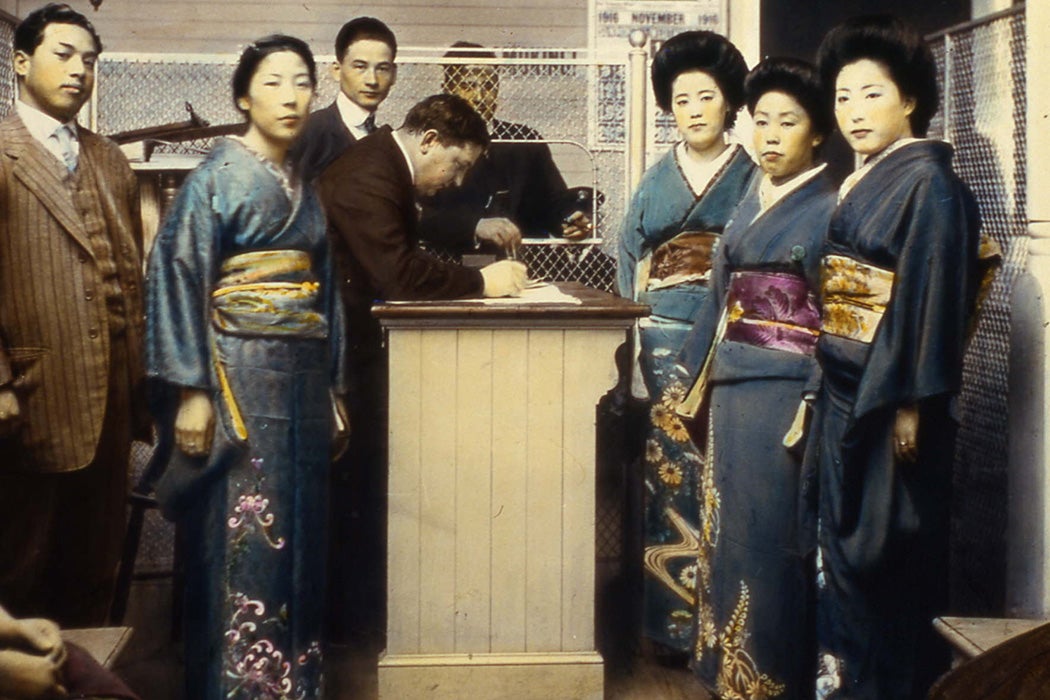Issei women—first-generation Japanese immigrants—are typically remembered and celebrated in popular narratives for their domestic roles in supporting the household. Indeed, Japanese leaders put pressure on women “to conform to the idealized image of Issei women as ‘good wives and wise mothers,’” scholar Kazuhiro Oharazeki reports.
But these immigrants’ status as wives may have obscured a parallel history of the sex industry in the American West—especially as Oharazeki notes that prostitutes comprised “a significant part of the Japanese population in the early stage of migration” to Hawaiʻi and North America in the late nineteenth and early twentieth century.
“Their stories challenge the conventional images of prostitutes as victims and Issei women as mothers,” he writes, “illuminating varied forms of gender relations and the disruptive nature of sexuality in the social formation of the Japanese immigrant community in the North American West.”
By the late 1890s, Japanese consulates had more than 300 emigrant sex workers on their books in the western United States, nearly half of whom were registered in California. The sex industry was “stratified by race and ethnicity,” according to Oharazeki, who recounts that “Japanese women were divided into ‘White,’ ‘Japanese,’ and ‘Chinese birds,’ according to the types of customers they served,” reflecting the prejudices of each group of clients. Sex workers’ rates also varied by race. In late nineteenth-century San Francisco, Chinese, Japanese, and Black women charged $0.50 for sexual services—lower than the $1.00 charged by “native-born girls” but twice that of the $0.25 that Mexican women could expect.
For Japanese women, involvement in the sex trade often had a close link to their marital status. Oharazeki writes that some “arrived at the US ports of Seattle and San Francisco as ‘wives’ of procurers to evade the suspicion of immigration officials,” while others came as “picture brides” whose marriages with men residing in the US were arranged on the basis of their photographs. Some unfortunate picture brides soon discovered that their husbands were not who they had expected. Oharazeki notes that “procurers created several versions of ‘American stories’ to lure young women to believe that better opportunities beckoned across the Pacific.”
In other cases, he writes, “[t]he root cause that pushed Japanese immigrant women into the trade was Japanese men’s inability to support their wives.” Fujimoto Harue, a picture bride in the 1910s, was wed to a gambler with mounting debts. To support the family, she worked as a barmaid, which was an occupation associated with sex work.
Yet, not all women entered the industry passively. One named Otaka arrived in Seattle in 1912 on the pretext of joining her husband, Takahashi Mineichi, but she already intended to leave him for another man.
Weekly Newsletter
“She migrated as a married woman (rather than a barmaid) to insure her safe entry into the country, and once reaching Seattle, negotiated divorce with her husband,” promising to pay him $700, Oharazeki writes. Consequently, she arranged to work as a barmaid to earn the “consolation money” she owed Mineichi.
“The consolation payment was a kind of compromise between prostitutes and their employers or husbands,” explains Oharazeki, who connects this practice with a historical Japanese custom of private divorce—“by mutual consent”—that continued into the mid-twentieth century.
Divorce was also an option for married women who had been forced into prostitution by their spouses. Hiring lawyers and interpreters, “more assertive women used the American judicial system to end their relation with pimp-husbands,” Oharazeki writes. But he cautions that these women’s experiences were shaped by “the nature of the American economy that historically had exploited Asians as disposable labor, race-based immigration policy… and the continuing influence of the patriarchal family system.”
Still, he adds, “[W]hat is striking in the analysis of their stories is the women’s clear understanding of their life circumstances, their pragmatic attempts to improve their lives by using available resources, and the absence of any particular class, racial, or feminist rhetoric.”







